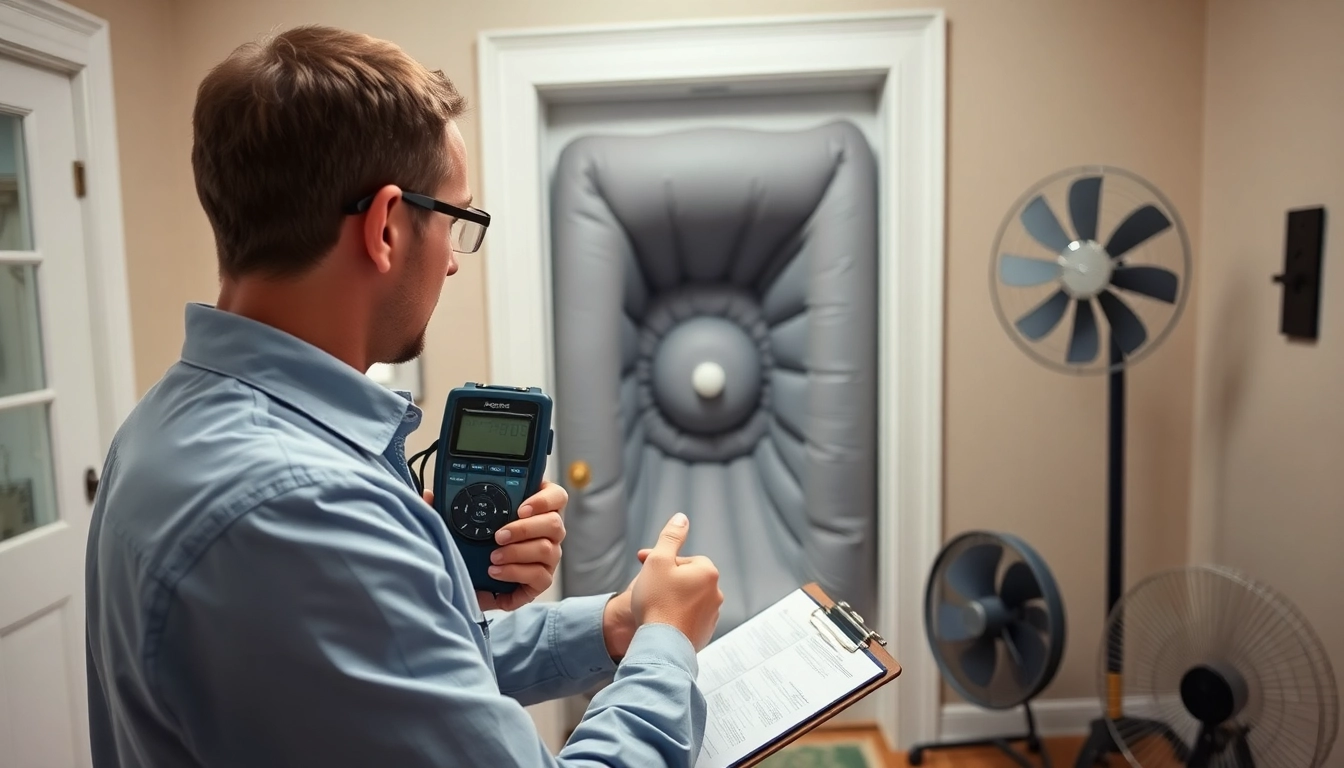Finding Reliable Blower Door Test Companies for Accurate Home Assessments
Understanding Blower Door Testing
What is a Blower Door Test?
Blower Door Testing is a diagnostic procedure designed to measure the air leakage of a home or building. This assessment employs a specialized fan that depressurizes the building. During the test, the fan is placed in a doorway, creating a difference in air pressure between the inside of the home and the outside environment. This results in measurable airflow rates, allowing professionals to ascertain how much air is leaking through the building envelope.
Typically utilized in energy audits, Blower Door Tests offer invaluable insights into a structure’s thermal efficiency. The results highlight specific areas where air leakage occurs, indicating potential points of improvement for homeowners and builders alike.
Purpose of Blower Door Testing for Homes
The primary purpose of conducting a blower door test for homes is to identify areas of energy inefficiency. In an era where energy costs are constantly rising, it is essential to have a well-sealed structure to ensure optimal energy use. Here are some key objectives of blowing door tests:
1. Energy Efficiency Evaluation: The test quantifies the energy loss points in a home. By highlighting these inefficiencies, homeowners can make informed decisions about repairs and renovations.
2. Indoor Air Quality Improvement: By identifying leaks, homeowners can better manage their indoor air quality. Sealed spaces limit the entry of pollutants, allergens, and unwanted moisture.
3. Compliance with Building Codes: Many building codes now mandate specific air leakage ratings for residential structures. A blower door test can confirm compliance, ensuring that newly constructed or renovated homes meet these standards.
4. Assessment for Energy Incentives: Many energy programs provide incentives for homes that meet specific energy efficiency guidelines. A blower door test is often a crucial step in qualifying for these benefits.
How Blower Door Tests Work
Blower door tests work through a systematic method that includes several steps:
1. Preparation: Before testing, all open windows, doors, and vents should be closed or sealed. It is also important to check for any existing mechanical systems that may affect the results, like exhaust fans or HVAC.
2. Calibration: The blower door, which consists of a frame and a variable-speed fan, is calibrated to measure the home’s envelope pressure accurately. This fan is mounted in an exterior door or an opening designed for testing.
3. Depressurization: Once the blower door is set up, the fan creates a controlled depressurization within the home. This pressurization allows for accurate measurements of airflow.
4. Air Leakage Measurement: During the test, the airflow is quantified—often reported in cubic feet per minute (CFM)—giving a clear picture of how much air is leaking from the residence.
5. Analysis: After the test, a detailed report is generated, outlining areas with the highest rates of air leakage. This report serves as a resource for homeowners to make necessary repairs or enhancements.
Benefits of Blower Door Test Companies
Choosing professional blower door test companies offers several significant benefits when it comes to assessing and improving a home’s energy efficiency:
Improved Energy Efficiency
One of the most notable benefits of engaging blower door test companies is the resultant improvement in energy efficiency. By identifying leaks and conducting necessary repairs, homes can significantly reduce their energy consumption. When air leaks are sealed, a home requires less energy to maintain comfortable temperatures, leading to a decrease in utility bills.
The actual energy savings can vary based on the severity of leakage within the home. In some cases, homeowners report a reduction of up to 30% in energy expenditures post-testing and repairs. This alone can lead to significant financial benefits over time.
Enhanced Indoor Air Quality
In addition to energy savings, blower door tests can drastically improve indoor air quality. Air leaks can bring in allergens, dust, and pollutants from outside, potentially causing health issues for inhabitants. By sealing these leaks, homeowners can maintain a healthier indoor environment with better-controlled humidity and fewer outdoor contaminants.
Moreover, enhanced indoor air quality often leads to an increase in overall comfort for the residents, improving their living experience within the space.
Compliance with Building Codes
Many local building regulations require a formal assessment of air leakage for new constructions or substantial renovations. Hiring professional blower door test companies helps ensure compliance with these codes, reducing the risk of costly redesigns or fines. Compliance often reflects positively during resale, demonstrating to potential buyers or inspectors that the home meets mandated energy efficiency standards.
Additionally, passing these tests can potentially qualify homeowners for various rebate programs and incentives designed to upgrade homes to more energy-efficient standards.
Selecting the Right Blower Door Test Companies
With numerous options available, selecting the right blower door test company can be challenging. To ensure you’re making a wise choice, consider the following factors:
Key Qualifications to Look For
When searching for qualified blower door test companies, it is essential to check the following qualifications:
1. Certifications: Ensure the company holds relevant certifications from recognized institutions. This indicates a level of proficiency and adherence to industry best practices.
2. Experience: Inquire about the company’s experience in the field. Established companies with a track record in conducting blower door tests will typically have more refined processes and insights to offer.
3. Knowledge of Local Codes: It’s critical that the company understands local codes and regulations surrounding energy efficiency and building standards. This knowledge positions them to provide thorough analysis and insight into compliance matters.
4. Insurance: Verify that the company carries adequate insurance coverage. This protects both you and the company in case of unforeseen incidents during the testing process.
Evaluating Customer Reviews and Case Studies
A great way to gauge the effectiveness of blower door test companies is by reviewing customer testimonials and case studies. Look for:
1. Client Feedback: Online reviews can provide insights into the company’s reliability, customer service, and the quality of their findings.
2. Before-and-After Studies: Successful case studies showcasing improvements in energy efficiency and indoor air quality after blower door tests can indicate a company’s capabilities.
3. Industry Reputation: Researching what others in the industry say about these testers can provide additional context to their performance.
4. Certifications or Awards: Recognitions from industry bodies or associations can indicate a company’s commitment to excellence and industry-leading practices.
Understanding Pricing Structures
Pricing for blower door testing can vary significantly based on various factors, including the size of the home, geographical location, and additional services offered. When evaluating pricing structures, consider the following:
1. Standard Rate vs. Additional Services: Some companies charge a flat fee for the blower door test, while others may have variable pricing depending on services like detailed reports or follow-up consultations.
2. Comparative Quotes: It’s advisable to obtain multiple quotations for comparison, ensuring you understand what’s included in the price.
3. Value for Money: Low prices can be enticing, but ensure you’re receiving a comprehensive service rather than a superficial assessment. Often, it’s worth investing in an established company known for thoroughness and accuracy.
4. Potential ROI: Consider the long-term savings on energy bills as well as potential rebates when evaluating whether or not to choose a particular company.
Preparing for a Blower Door Test
To ensure accurate results and a smooth testing process, homeowners must prepare adequately for a blower door test. Here are essential preparations to consider:
Necessary Home Modifications
Proper preparation can significantly influence the outcomes of a blower door test. To optimize the testing environment, the following modifications may be necessary:
1. Seal Openings: Close all doors, windows, and vents to minimize external airflow intrusion. Ensure all flues and chimneys are blocked if they are not being assessed.
2. Turn Off Appliances: Turn off any exhaust fans, heaters, or air conditioning units during testing to avoid skewing results.
3. Assess Existing Conditions: Identify potential problem areas, such as drafty windows or doors, which may require additional focus during testing.
4. Clear Accessibility: Ensure that the area around the testing point is accessible, allowing the technician to set up equipment efficiently.
Scheduling and Timing Considerations
Scheduling the blower door test is another critical element of preparation:
1. Choose an Optimal Time: Testing should be conducted on a day with mild weather conditions to ensure that external factors do not skew the results. Additionally, scheduling at a time when you can be present is beneficial for answering any questions the technician may have.
2. Plan for Duration: The extent of a blower door test depends largely on the home’s size and complexity; prepare to allocate a few hours for the complete assessment.
3. Coordinate with Other Services: If your analysis is part of a broader energy audit, ensure that your blower door test is coordinated effectively with other services being performed.
Questions to Ask Your Tester
Before the blower door test begins, it’s advisable to engage the technician with relevant queries:
1. Experience and Certifications: Ask about their experience in conducting blower door tests and about any certifications they hold.
2. Testing Methodology: Inquire about the specific methods they employ during testing and how they intend to analyze the results.
3. Post-Test Support: Discuss what support they offer after the test, such as recommendations for improvements, follow-up testing, or assistance with repair assessments.
4. Expected Timeline for Results: Understanding when you can expect to receive the test results can help you plan for any necessary next steps.
Interpreting Blower Door Test Results
Once the blower door test is completed, interpreting the results is crucial for subsequent actions. The findings will typically elucidate the air leakage rate and highlight significant problem areas.
Understanding Air Leakage Measurements
The results of a blower door test will often be presented in terms of CFM (cubic feet per minute), which reflects the volume of air lost due to leaks.
– Air Changes Per Hour (ACH): A common measurement used to indicate how many times the air in the house is replaced in an hour. This figure helps homeowners determine how leaky their home is; lower numbers signify better overall performance.
– Leakage by Area: Results may also break down information by square foot, informing homeowners about the specific leakage points and their significance.
Understanding these figures is vital as they help homeowners prioritize repairs based on severity and impact.
How to Use Results for Home Improvement
Results from a blower door test can be employed to inform a variety of home improvement decisions:
1. Targeting Repairs: Use the findings to focus on high-leakage areas for sealing, insulation, or remediation efforts. This strategic targeting ensures that repair resources are used efficiently.
2. Designing Retrofit Strategies: Homeowners can approach home upgrades with clarity, knowing which elements need the most attention first.
3. Diving Deeper into Energy Audits: The results of a blower door test often dovetail perfectly with comprehensive energy audits. If further testing or expansion into additional areas is warranted, these results can serve as a foundation.
4. Prioritizing Investments: Use the test outcomes to create a timeline for improvements, allowing homeowners to allocate resources effectively over time rather than investing in potentially ineffective changes initially.
Next Steps After Testing
After completing the blower door test, several key actions can be taken:
1. Analyze Results with a Professional: Engage with an energy efficiency professional to interpret the findings and suggest actionable next steps.
2. Create a Remediation Action Plan: Based on results, prioritize the necessary sealing, insulation, or structural adjustments.
3. Conduct Follow-up Testing: After repairs and improvements, it’s prudent to schedule another blower door test. This reassessment ensures that air leakage has been sufficiently addressed.
4. Monitor Energy Use: After improvements have been made, observe energy bills and consumption patterns to gauge the effectiveness of the changes implemented.
By implementing these steps, homeowners can maximize the benefits derived from blower door testing, fostering enhanced energy efficiency, improved indoor air quality, and increased comfort within their living spaces.














Post Comment